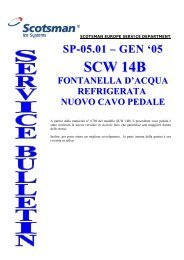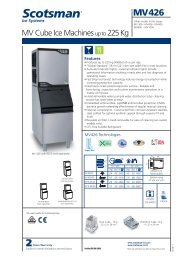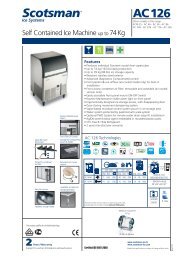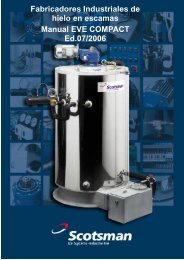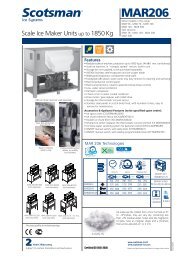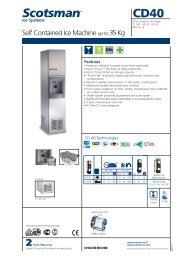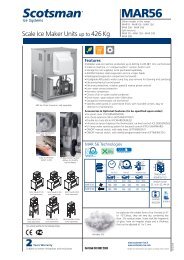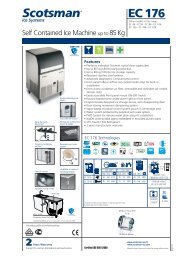Ed. 07/2006 - Scotsman
Ed. 07/2006 - Scotsman
Ed. 07/2006 - Scotsman
You also want an ePaper? Increase the reach of your titles
YUMPU automatically turns print PDFs into web optimized ePapers that Google loves.
Service manual<br />
To help with the priming if the brine solution is very concentrated, remove the air from the<br />
valve pipe with a 20 cc syringe after having started the pump and opened the valve.<br />
The feeder pump is provided with a level alarm. When the brine falls below the minimum<br />
level, a red LED will light and the pump will stop.<br />
The dosage is constant, with the possibility of modifying the flow rate from zero to 100%.<br />
The front panel handle allows modification of the electronic system. It is advisable not to<br />
adjust the pump flow from 0 to 10% because this may cause an irregular flow rate.<br />
The bottom part of the filter should be cleaned once a year but if there are crystals<br />
present, it is suggested that cleaning should be carried out more frequently.<br />
WATER/BRINE TANK<br />
To avoid saturation of brine do not add more than 30% of salt by weight.<br />
As adjustment of the pump regulates the brine flow rate it is possible to meet the majority<br />
of customers’ requirements in respect of ice hardness and temperature.<br />
b2. manual dispenser pipe in Plexiglas: compressed salt tablets should be inserted<br />
and the hole at the bottom of the pipe should be gradually enlarged<br />
until the correct dosage is reached, this depends on the water hardness.<br />
NOTE: When the machine is stopped for a long period, the Plexiglas pipe<br />
should be removed to avoid re-starting with increased concentration of salt.<br />
This may lead to a formation of ice that is too soft and could block the<br />
ice-breaker.<br />
b3. manual dispenser drawer with double basin: add salt to the external basin;<br />
regulate the flow of water until the desired condition is achieved.<br />
With sea water machines it is not necessary to use these methods.<br />
If a variation in the quality of the ice (temperature) is required, it is not necessary to make<br />
alterations to the refrigerant system, it is enough to close the last holes in the distributor<br />
(closest to the ice-breaker) thereby obtaining a greater sub-cooling surface.<br />
However, on all machines, the opening of the thermostatic valve or damper can be<br />
regulated to alter the expansion temperature for a greater or lower sub-cooling of the ice.<br />
If the ice production is too low, proceed as follows:<br />
- from the inspection window check the frosting on the evaporator surface if this is not<br />
complete, open the thermostatic valve to increase the quantity of refrigerant<br />
- re-check the level of frosting, proceeding as above until maximum production is<br />
reached.<br />
- if necessary add more refrigerant (sight glass with presence of bubbles)<br />
If you wish to use the ice machine to obtain a daily amount which is lower than its capacity,<br />
it is advisable not to alter the refrigerant system but to stop the machine when the required<br />
amount of ice has been produced (timer or manual operation by the operator).<br />
Only in cases when the reduction has to be referred to the hourly production is it advisable<br />
to make alterations to the refrigerant circuit, reducing the refrigerant power of the<br />
compressor (partialisation or variation of a number of turns) and at the same time reducing<br />
24<br />
Rev. <strong>07</strong>/<strong>2006</strong>




